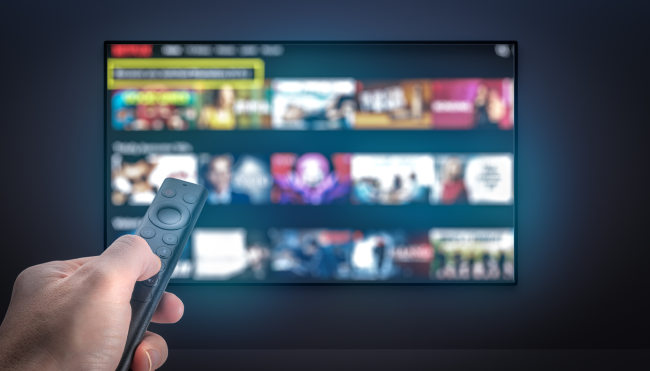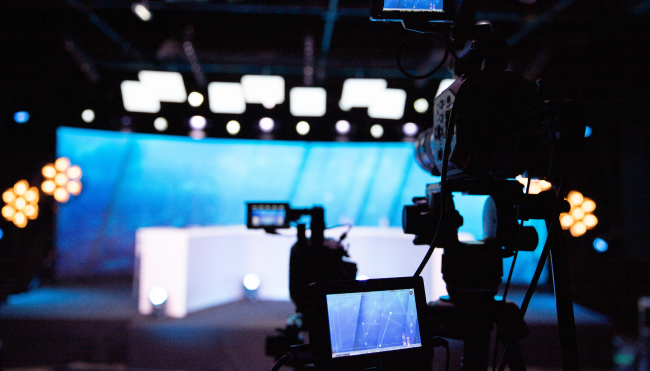- Why Amagi
-
Solutions
Contact UsBusinessWho We Serve
- Offerings
- AI
-
Resources
Contact UsINDUSTRY REPORTSAmagi FAST Report #15: The Power of Live Programming: A Catalyst for Streaming SuccessAugust 21, 2025Read More
-
Company
Contact UsNewsroomAmagi launches AI-powered Smart Scheduler to improve content programmingApril 3, 2025Read More
Blog
Q&A with Alan Wolk: FAST’s future, global growth, advertising impact and more
By Amagi Editorial Team - December 12, 2023
TVREV Co-Founder and Lead Analyst Alan Wolk joined us for a sit-down interview at our LA FAST conference this fall to discuss the state of FAST. The below conversation has been edited for clarity and length.
Amagi:
Let's talk a little bit about the different types of FAST. Those owned by OEMs and then ones owned by distribution companies and independents. What are the differences there?
Wolk:
First off, I want to make a big distinction … FAST channels and FAST services are two different things. So Pluto TV, VIZIO WatchFree, Roku Channel – those are FAST services. Within the FAST services, there are FAST channels. Within FAST services, there are three different types.
The first ones are owned by the OEMs. That's everything from the Roku Channel, Samsung TV Plus, LG, Amazon, VIZIO. What they have going for them is that they are the interface of the device. So you turn on the TV, and that's what you see. It makes it easier for them to get people to watch, because I don't know that people necessarily go ‘Oh, that's the service from [my TV],’ as much as they go, ‘Here's a bunch of free TV shows that I can watch when I turn on my device, which is pretty cool.’ And it also gives them a line of business where they're able to sell advertising.
Second are the ones owned by big media companies. Pluto, Tubi, Xumo, for the most part – in the US anyway. Those companies were sort of the first ones out of the gate. They were all independent and got bought by media companies, and have a bunch of advantages too … the two big ones are, they are available on any and every device, and they have much wider distribution. Versus the OEM, only if you have that device do you see it.
READ: The top 5 broadcasting and streaming industry trends of 2023
They all have fairly massive libraries from the parent companies that own them. Pluto, for example, has content from Paramount, which is CBS and Viacom and Nickelodeon and MTV, that is often but not always exclusive to them. In other words, they may choose to license some of it out, but they have a whole thing of that and then that allows them to differentiate themselves. And the other thing that is an advantage for them is they're able to use their FAST service to promote their SVOD service. NBCU and Paramount have paid streaming services and they're able to take a show from their paid streaming service and promote it and say, ‘We'll show last year’s episodes on our FAST and get people to go ‘Oh, I want to keep watching.’
Amagi:
Can we talk a little bit about the impact of advertising for FAST?
Wolk:
Finally, they have some place on streaming to follow the eyeballs and put inventory. For a long time, really, the only place you could run ads on streaming was on Hulu, and then everybody came along. So now with FAST, it gives them a way to run advertising where so much of their audience is now. One of the things that’s interesting, that we hear from a lot of the very big advertisers, the guys who are spending nine figures, is they make these commercials for $2, $3 million. And they don't necessarily want to run them against what they consider basically reruns. They want to run them against original programming. The SVOD services – Netflix, Disney, Max, all have nascent ad-supported tiers. So once that gets to a level, then it's just gonna be like, ‘Oh, I get it. That's primetime and faster than new cable so this is where we reach all the audiences that were missing on primetime. All the specific audiences, we can do a lot more than we could do on cable. We can do specific geotargeting, we can do audience segmentation, we can do contextual.’
That's going to be huge for them, for advertisers, as a way to reach where most of their audience is, especially the most desirable audiences.
READ: Top 3 FAST monetization strategies to drive revenue
Amagi:
Let's talk a little bit about data and AI, and how those two things can actually improve the level of personalization for the lean-back experience of FAST.
Wolk:
Because FAST is digital, you have so much data about who's watching, where, when and all that, and so they're able to personalize the advertising based on audience segmentation. If I want to reach a certain demo, I can reach them. Geolocation gets very specific. Say I’m a chain of restaurants and I have 10 stores in the Cincinnati area, but one of them is actually in the Indianapolis DMA. It's not a problem. I just say, ‘Okay, these zip codes, boom, go.’
The other piece is contextual. That's becoming a really big thing now where advertisers are realizing, ‘Okay, the big difference between digital advertising and television is that television has emotion to it.’ Their ads are funny, they're sad, they're poignant, whatever. And so I don't want my funny ad running during the funeral scene on your show, even if it’s hitting my demo. So I can use contextual cues which is where AI comes in. AI can really look at a scene and say, here's what's happening in it, here's who the actors are in it. So if I'm Cadillac, I can run my ads in scenes with Matthew McConaughey and really get extra bang for it, or I can say ‘Okay, if someone is ordering a pizza in a scene, and I'm Domino's, I can run my ad there,’ and that's a huge game-changer because it feels much more natural to the scene.
Amagi:
Your recent report … I know there were a few themes. One was local TV. News, in particular, moving to FAST (and broadcasters moving to the cloud). What were a few key themes?
Wolk:
One of the things we found is that local broadcasters are realizing that in the next 10 years everybody's just going to be watching streaming. The infrastructure bill is filling in a lot of the rural areas where they used to not get any sort of internet connections, everything's moving to streaming and they're realizing ‘Okay, we can do really cool stuff with our local news.’
We did a consumer study and found that local news is huge at all ages. Even with older Zoomers and Millennials. And so what they can do is, they can look at what the cable companies used to do. Charter, in particular, where they would run 24-hour local news stations. And it's like, ‘Okay, we can do this, but we have data now. We can make them even cooler.’ If you're in Los Angeles, you can have one set of news … if you know someone's in the San Fernando Valley, have the news focused on that. If you know someone's really into sports, have more sports news and lead with that.
READ: How sports content owners can leverage FAST to boost revenue, reach and engagement
And the personalization is incredible … what they'll be able to do with that and really make that a destination for local viewers on the FAST, which then pushes the other programming on the FAST because they're like, ‘Oh, hey, I came for the news. But look, what else is there? I'll start watching this too.’
Amagi:
Anything unique within the last year that's starting to change from your reports?
Wolk:
One of the things we found is that everybody is watching their local news on streaming now. Obviously the younger demo is very big on that but even people over 45, a decent percentage of them are seeking out their local news on streaming. The other thing which I thought was fascinating was that people tend to pick local news broadcasts based on the weather forecasts, not, as I would have bet big money on, the likability of the anchors.
And also that people feel really strongly about local news and local coverage in general, regardless of age, regardless of income. So it really cuts across all levels.
And then there's a decent number of younger people aged 25-34, who are still watching local broadcast TV at least once a week. I think it was like 25% or so but that's more than people think. And it makes sense if you think of it that, you know, as we've had this sort of national monoculture, it's great, but it tends to focus on New York, Los Angeles, maybe DC, San Francisco and not the rest of the country. And if I'm in Indianapolis, if I'm in Salt Lake City, I want my local news. I want to know what's going on. And that's going to be huge.
Learn more: Visit Amagi’s FAST Center
Amagi:
The theme that I find in a lot of your reports is that FAST is the new cable. What are some of the similarities and differences in your opinion?
Wolk:
The big similarity, and it's funny, they both had the same reaction at the start, which was like, ‘Why would someone watch this? What's the appeal?’ FAST initially, the pushback we'd get here was, ‘It’s a bunch of reruns, the big SVOD services all have huge libraries. Why would someone watch this?’ The linear channel thing was huge. The fact that I could just turn this on and recreate that experience and not have to make a decision all the time.
We're also starting to see a shakeout similar to what happened in cable. In the early days, it was like, ‘Oh, let's see, we'll just take anything. You got some shows? Great. We'll stand up a channel for you.’ Now all the big FAST services are like, ‘We have enough and let's move to quality.’ We've been calling it the push to quality, where it's like, ‘Okay, get rid of stuff that people don't watch that much or that's not really high quality programming.’ That happened in cable too where initially it was just a mass of stuff and then they all started having personalities. And I think the next step is going to be more original programming. So I think that's going to be something that we see in different stages. So say Amazon Freevee has all of Jeff Bezos’ money and they can make shows like Jury Duty and all that, but I think a lot of the other FAST services will concentrate on things like courtroom shows, judge shows, game shows, talk shows. We always forget Oprah Winfrey herself started out on a local talk show. Those are huge, and I think a lot of the FAST services are going to realize, ‘Okay, here's how we serve local audiences.’
Amagi:
Crystal ball, where do you see FAST headed in the next 2-3 years, or even beyond that?
Wolk:
I think a couple things are going to happen. One, it's going to continue to grow and it's going to continue to attract viewers. I think the actual FAST services are going to start doing a lot more promotion, self promotion in the way that cable networks used to. So you'll see billboards like, ‘Tune in to Beverly Hillbillies on Pluto at 6 p.m,’ sort of old-school to try and drive tune-in aimed at consumers.
I think we're going to start seeing, once the SVOD services, once their ad-supported tiers take off, we're going to see a lot more money going into FAST because then all the big advertisers say ‘Okay, that's our primetime.’ And cable took a while too before advertisers realized, ‘Okay, we can hit all the people who are missing elsewhere on here, we can hit specific demos, we can hit specific geos. There's a lot we can do with this, and it's a great complement.’
FAST is going to be the way people in much of the world watch television. -- Alan Wolk
Then I think we're also going to see it going global. We're already starting to see that … Pluto in particular, I think is in 30-some-odd countries at this point. Tubi is expanding globally. And it makes sense because our belief is that FAST is going to be the dominant way people watch TV in the world because [in parts of the world where] there aren't that many people who can afford subscription services for Netflix to go in and say, ‘Okay, we're gonna dominate this country.’ No, you're not. If everybody who can [watch Netflix actually watched Netflix], maybe that's 10 or 15% of the population who has that sort of income. So FAST is going to be the way people in much of the world watch television.
Amagi:
Now that the Writer's Strike has ended, what’s your opinion on the impact on content going forward?
Wolk:
I think it's going to be a positive thing. Mostly the writers got what they wanted from the studios, which was fair. On the other hand, I think as an industry, we’ve really got to come to terms with the fact that the television industry in the US is never going to be as lucrative again as it was in the 90s, aughts and teens. And that's because carriage and retrans fees, what consumers paid to the cable companies, which then passed it on, is literally tens of billions of dollars a year.
For example, Fox in their Q2 earnings report for this year, $1.77 billion in affiliate fees just in that quarter, and just from Fox. There's a huge amount of money and that goes away with streaming. They will be able to make it up, some on subscription and some on advertising and it will be a lucrative business. It'll be a very profitable business. It will not be as insanely profitable as it was back in the day. But I think if everybody is feeling better about how streaming is working and what their stakes are, I think we'll see renewed creativity. I also think that this ‘We have to pump out 500 original series a year thing’ is over now. People realize quality over quantity, and I think that's going to be a good thing, too.
DOWNLOAD: Amagi’s Global FAST Industry Report
Amagi:
Any topic or theme you'd like to discuss regarding FAST that I may not have asked in this interview?
Wolk:
One of the big things, I know Tom Ryan from Pluto, this is his baby, is curated channels. Where can we make the equivalent of what Netflix used to do? If you remember back in early Netflix, they would have [lists like], “Dark movies with dark-haired women.” And I think we're going to start seeing a lot more of that on the FAST–curated channels as a way to set themselves apart, whether it's specific genres or whatever it is aimed at this specific audience. A lot more local content too, local base content, but I think that's really going to set them apart in addition to interface because they really do need to distinguish themselves from each other because they’re all national.
To watch our full interview with Alan Wolk, click here.
Want to learn more about FAST?
- Get in touch and send us a note
- Receive your personalized FAST assessment and talk to our experts at Amagi Consulting Services
Related Blogs
Get started
Increase revenue and reach with our Broadcast & Streaming solutions.
Cloud modernization. Streaming unification. Monetization. Marketplace.
 German
German French
French Spanish
Spanish Korean
Korean Japanese
Japanese Portuguese
Portuguese


